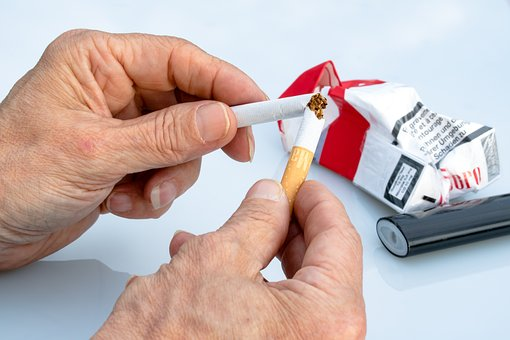Silenttest.com may earn a commission when you purchase products from companies we are affiliated with through promoting their products, at no extra cost to you. Prices are the same when buying products through an affiliate or non-affiliate link. Full Disclosure
Nicotine Replacement Therapy (NRT) is a treatment that helps people quit smoking by reducing nicotine withdrawal symptoms.
The goal of NRT is to gradually reduce the amount of nicotine in the body through the use of gummies, inhalers, patches and lozenges, and eventually wean the person completely from nicotine.
NRT has proven to be an effective tool to help people quit smoking. It can double the chances of quitting smoking for those who use it compared to those who don’t.
Overview of nicotine addiction


Nicotine addiction is an intricate process that involves changes in how the brain and body respond to nicotine, the addictive substance found in tobacco products such as cigarettes, cigars and chewing tobacco.
When nicotine is ingested or inhaled, it enters the bloodstream and flows to the brain, where it binds to specific receptors on nerve cells that release dopamine, a neurotransmitter associated with pleasure and reward. Release of dopamine creates a feeling of pleasure and reinforces nicotine consumption behavior.
Over time, the brain becomes more tolerant of the effects of nicotine, meaning that larger amounts of nicotine are required to achieve the same level of pleasure and satisfaction. This leads to a cycle of increased nicotine consumption that can ultimately lead to addiction.
Nicotine addiction also involves a range of psychological and social factors such as , social pressure, stress and addiction. People may use nicotine to cope with stress and anxiety, to fit into social groups, or simply out of habit.
Physical and psychological dependence on nicotine can make it hard to quit smoking or use other tobacco products. Withdrawal symptoms like anxiety, irritability, and cravings can make quitting smoking difficult, even for those who want to quit.
Despite, you can use a nicotine replacement therapy in conjunction with a program to help you fight anxiety and other side effects that comes with quitting smoking.
Effective treatments for nicotine addiction often involve a combination of Nicotine Replacement Therapies, behavioral therapy, medication, and support from family, friends, or support groups.
Quitting smoking can improve your overall health and reduce your risk of serious health problems like lung cancer, heart disease, and stroke.
what is nicotine replacement therapy


Nicotine Replacement Therapy (NRT) refers to the use of products designed to help people quit smoking. These products include nicotine patches, gum, lozenges, inhalers and nasal sprays, which are available in many countries without a prescription.
The idea behind NRT is that it delivers a lower dose of nicotine than smoking, which helps reduce nicotine cravings and withdrawal symptoms.
When trying to quit smoking, you can gradually wean off nicotine while avoiding many of the harmful chemicals found in cigarette smoke.
NRT is often used as part of a comprehensive smoking cessation program that may also include counseling, support groups, and other forms of treatment.
It is important to note that while NRT may be helpful for some people, it is not a magic bullet for smoking cessation and success rates depend on various factors such as a person’s level of addiction, the support they have and their rationale for quitting.
Forms of Nicotine Replacement Therapy


NRTs are said to help reduce nicotine withdrawal symptoms, including nicotine cravings, difficulty concentrating and irritability.
You can use NRT one at a go or in a combination of two together with other smoking cessation therapies such as nicotine hypnosis programs.
1.Inhaler: This is a device that imitates the hand to mouth habit, designed to imitate the hand to mouth habit, but wit an aim to help you quit smoking in a natural way.
It is a wise idea to replace the common nicotine with an Aromatherapy Inhaler. No vapor, no nicotine, and no toxins or smoke. It is made of natural plants extracts.
Besides, it is a great way to curb anxiety, its calming and accompanied by a variety of flavors, spoiled for choice!
2.Gum: nicotine gum is appropriate in helping you quit smoking fast than it could without it. Nicotine gum comes in different strengths and the user chews it on a set schedule.
3. Patch: This is a small sticky patch and it is placed on the skin, and probably on the chest or the arm. The patches are available in different strengths and are worn over a longer period of time.
4.Lozenges: This is a tablet that looks like a Candie where you put it between the cheeks and the gums. There are different strengths of the lozenges and they are used on a set schedule.
5.Nasal Spray: This is a device used to deliver a fine mist into the nose. Nicotine is absorbed through the nose and may require prescription.
How does Nicotine Replacement Therapy Works


Nicotine replacement therapy can be a useful tool for someone looking to quit smoking by reducing withdrawal symptoms and gradually reducing nicotine intake over time.
Please note that this is only part of a comprehensive smoking cessation plan and may work differently for different people. Here’s how it works:
- Reducing Nicotine Withdrawal Symptoms
Nicotine is addictive and withdrawal can produce a variety of symptoms including hunger,, restlessness, irritability, restlessness, difficulty concentrating, depression and increased appetite.
NRT reduces these symptoms and making it easier to stop smoking.
- Mimicking Smoke Nicotine
NRT products works by mimicking the effects of smoke nicotine. It enters the bloodstream through the skin (patches) or mouth (gums, lozenges, or inhalers) and travels to the brain, where it binds to nicotine receptors, releasing dopamine (a feel-good chemical) and lowering blood sugar.
- Nicotine cessation
The main goal of NRT is to help people quit smoking. Remember they are only to be used by those who wan to quit smoking.
NRT gradually reduce the nicotine intake over time and eventually quitting altogether. Most NRT programs recommend gradually reducing nicotine levels, starting with high-dose products and gradually moving to low-dose products over several weeks or months.
- Individualized Treatment Plan
Nicotine replacement therapy works best when used as part of an individualized treatment plan, which may include behavioral counseling, support groups, and other forms of treatment.
Effectiveness of Nicotine Replacement Therapy


NRT has been effective in helping smokers quit. It has therefore been a potential smoking cessation tool.
It can approximately increase the likelihood of successful smoking cessation by 60-70% compared to no treatment. Using NRT for 6-12 weeks can increase the success rate by 2 times.
NRT reduces withdrawal symptoms associated with quitting and nicotine cravings. This can help you stay motivated and be patient with quitting nicotine.
However, NRT is not a stand alone problem solver to quitting smoking. Instead, use it in conjunction with other behavior and lifestyle changes, like support groups, counseling, and exercising, to increase your chances of success.
Side Effects of Nicotine Replacement Therapy


NRT is generally regarded as safer for use than smoking and the effects of NRT tend to be less severe than when smoking. Still, it’s important to use NRT as expected and you can also speak to your medical specialist if you notice unpleasant health concerns.
NRT is considered safe and effective when you use it per direction. On the contrary, there are some potential side effects of using NRT, but they happen only if you overuse or fail to follow instructions. Such effects includes:
Skin irritation: the types of NRT such as patches are applied directly on the skin and may cause skin irritation like redness or itching.
Nausea: NRT can make you feel sick, especially if you take it excessively or on an empty stomach.
Dizziness: You can feel light-headed when using nicotine replacement therapy..
Headache: Headache can occur while on NRT. But it most occurs when used in overdose. Follow instructions to avoid such problems.
Heart Rate increase: NRT can cause an increased heart rate, which can be a concern in people with heart disease.
Insomnia: You can also experience trouble sleeping or insomnia while taking NRT.
Addiction: Although NRT is designed to help in quitting smoking, there is a risk of addiction if used for too long or in high doses.
Note that, some of these effects only occur if you wrongly use the product, especially overuse. Follow the instructions as per how much you should take per day and watch yourself have a smooth experience with NRT.
Precautions for certain groups of people using nicotine replacement therapy
Some groups of people such as pregnant and breastfeeding women must take extra precautions when using any kind of NRT.
1.Pregnant women: Women during pregnancy should consult their healthcare providers before using any form of NRT. Although NRT is less harmful than cigarettes, it can still harm the fetus.
Your doctor can advise you on the best form of NRT and the appropriate dosage to take to quit smoking during pregnancy.
2.Breastfeeding women: Since anything breastfeeding women take is passed to the breast milk, breastfeeding women should consult the medic before using any NRT. Your doctor can advise you on the best NRT to use that is safe for you and your growing baby.
3.People with heart problems: NRT side effects can increase heart rate and also blood pressure. People with heart problems should therefore use it with caution. Consult with a doctor before using these products.
4.People with high blood pressure: Increased blood pressure can be caused by NRT usage. So people with this condition should be cautious when using it. It is advisable to sort health advice if in doubt of what will work for you.
5.People with diabetes: Nicotine can affect blood sugar. People with diabetes should therefore closely monitor their blood sugar levels when using NRT.
6.People with allergies: Some forms of NRT, such as nicotine patches, can cause allergic reactions in some people. Individuals with allergies should consult a doctor before using any form of NRT.
7.Children and adolescents: NRT is not recommended for children and adolescents under 18 years of age as no long-term effects are known.
benefits of nicotine replacement therapy


It can be a useful tool for those who are motivated to quit smoking and want to use it properly as part of an overall smoking cessation plan.
Here are some potential benefits of NRT
Reduces Nicotine Withdrawal Symptoms: NRT can help reduce nicotine withdrawal symptoms such as nicotine cravings, irritability, anxiety and difficulty concentrating, making it easier to quit smoking.
Increases chances of quitting smoking: Use of NRT can increase chances of quitting smoking by up to 60-70%.
Safer Than Smoking: NRT delivers a controlled amount of nicotine without exposing your body to the harmful chemicals found in tobacco smoke.
Available in Various Forms: NRT is available in various forms such as patches, gums, lozenges, inhalers and sprays, allowing patients to choose the method that works best for them.
FAQs
How long do nicotine withdrawals last?
The duration of nicotine withdrawal can vary depending on a variety of factors, including an individual’s level of nicotine dependency, amount and frequency of nicotine consumption, and the method used to quit smoking. Nicotine withdrawal symptoms can last for a few days up to a few weeks.
It is important to note that nicotine withdrawal is temporary and controllable. With the right support like medication, counseling, and lifestyle changes, you can successfully quit smoking nicotine and overcome withdrawal symptoms.
How can I stop smoking immediately?
Quitting smoking can be hard, but with determination, helpful tips, and the right support, it is possible. Here are some steps you can take to quit smoking immediately:
- Set a date to quit smoking
- Get rid of all smoking-related items
- Find support
- Get one Nicotine Replacement Therapy
- Make Lifestyle Changes
- Stay Involved
How long should nicotine replacement be used?
Nicotine replacement therapy products can be used for about 12 weeks. All the same, some individuals may require prolonged treatment and medical professionals may recommend longer use in certain cases like absence of recovery signs.
NRT is formulated to gradually wean the body off nicotine and is not a long-term solution. After using NRT, patients should reduce the dose and eventually stop using it.
Can I combine different NRTs?
Yes you can use a combination of more than 1 NRT. all you have to be careful is using too much of them 2 at a go is enough.
Final verdict
Using NRT is one of the most effective ways to quit smoking and at the same time curbing nicotine craving.
Everything needs protocol and for you to successfully quit smoking, you need to follow instructions of your preferred nicotine replacement therapy.
Side effects can be intent if only you overuse the product or use it wrongly. Orderness is key with NRT.
